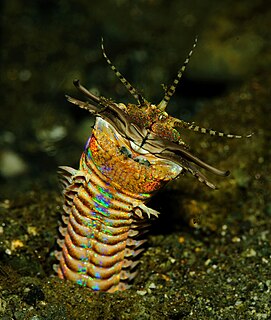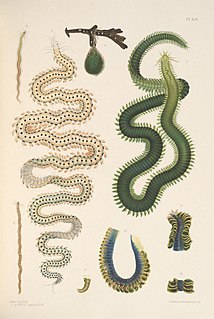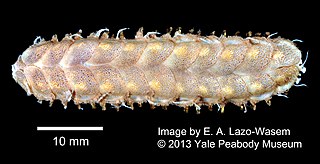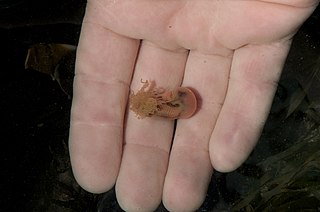
Nereis is a genus of polychaete worms in the family Nereididae. It comprises many species, most of which are marine. Nereis possess setae and parapodia for locomotion and gas exchange. They may have two types of setae, which are found on the parapodia. Acicular setae provide support. Locomotor setae are for crawling, and are the bristles that are visible on the exterior of the Polychaeta. They are cylindrical in shape, found not only in sandy areas, and they are adapted to burrow. They often cling to seagrass (posidonia) or other grass on rocks and sometimes gather in large groups.

The Terebellidae is a marine family of polychaete worms, of which the type taxon is Terebella, described by Carl Linnaeus in his 1767 12th edition of Systema Naturae.
Harmothoe is a genus of marine Polychaete worms belonging to the family Polynoidae. Species of Harmothoe are found world-wide to depths of at least 5,000 m but are more common in shallower water.

Eunice is a genus in the polychaete family Eunicidae. Individuals grow to a length of between 0.5 and 300 cm. Their bodies have multiple segments. They have two eyes and five tentacles. They have well-developed sense organs and relatively large brains. Their color is dark purple-brown to red-brown with a white ring at the fourth segment. They are found in oceans and seas around the world. They have an evertible proboscis with distinctive mouthparts, some of which comprise two rows of maxilliary plates in a radula-like fashion.

Ampharetinae are a subfamily of terebellid "bristle worm". They are the largest subfamily of the Ampharetidae, of which they contain the great majority of the described genera.

Hesionidae are a family of phyllodocid "bristle worms". They are marine organisms. Most are found on the continental shelf; Hesiocaeca methanicola is found on methane ice, where it feeds on bacterial biofilms.
Ampharete is a genus of polychaete annelid worms. They have a single, chevron-shaped row of teeth.

Phyllodoce is a genus of polychaete worms, which contains about 200 species. The prostomium bears eyes, two pairs of antennae and a pair of large retractile nuchal organs. The eversible proboscis is clearly divided into two parts.

Diopatra is a genus of polychaete worms in the family Onuphidae.
Amphinomidae, also known as the bristle worms or sea mice, are a family of marine polychaetes, many species of which bear chaetae mineralized with carbonate. The best-known amphinomids are the fireworms, which can cause great pain if their toxin-coated chaetae are touched or trodden on. Their relationship to other polychaete groups is somewhat poorly resolved.

Eulalia is a genus of polychaete worms.

Lepidonotus is a genus of marine annelids in the family Polynoidae. The genus occurs globally and includes 80 species, usually found in shallow waters down to about 80 metres.
Eunoe rhizoicola is a scale worm described from Punta Arenas, Chile at a depths of 4m.
Uncopolynoe is a genus of marine polychaete worms belonging to the family Polynoidae, the scaleworms. Uncopolynoe contains a single species, Uncopolynoe corallicola which is known from the Red Sea at a depth of 1 m.
Aglaophamus is a genus of free-burrowing nephtyid worms.
Amphitrite is a genus of polychaete belonging to the family Terebellidae. The genus has cosmopolitan distribution.

Thelepus is a genus of polychaetes belonging to the family Terebellidae.

Ophelina is a genus of annelids belonging to the family Opheliidae.
Armandia is a genus of polychaetes belonging to the family Opheliidae.
Lumbrineris is a genus of polychaetes belonging to the family Lumbrineridae.











